Island Of Brač – Places to visit
Published: August 20th, 2014
Author: Mate I
Brač is the one of the largest islands in Croatia, and also island of Brač has one of the highest mountain peaks among Adriatic islands with 778 meters high peak St. Vid located on Vidova Gora.
One of best known symbols of the island Brač is Zlatni rat beach in Bol, located on the island’s south side – this one of the most beautiful beaches in entire Adriatic sea.

Zlatni Rat or “Golden Horn beach” is just one of many places of exceptional beauty that you can find on island Brač.
You can also find there a places full of traditions and secrets that will make your vacation complete.
Brač island historical heritage and a vital folk culture provide a perfect setting for a vacation filled with unforgettable experiences.
On the island there is a large offer of quality accommodation services so you wont have to worry about that.
During the summer season in most places on Brač there are great number of traditional folk festivals and other cultural events. Local people of Brač all gather in a procession celebrating St. Vid on Vidova Gora.
Among the most interesting events on the island is “Vanka Regule” festival (No Rules) held at the end of July in Sutivan.
The event includes extreme sports competitions, informative lectures, promotions, equipment, courses, a festival of documentary films about sports – complemented by rich nightlife with music concerts.
Brač is separated from the mainland by the Brač Channel (north side), from the island of Šolta by the so-called Splitska Vrata (Split Gate) on west side and from the Island of Hvar on south side by the Hvar Channel.
Inland landscape of island Brač is dominated by a karst limestone relief, with numerous gullies, crevices, cavities, round valleys and coves.
Milder forms of the relief, with brown Primorje soils whis is the most fertile on the island, are found mostly in the interior especially between Ložišća and Nerežišća, as well as between villages of Selca, Novo Selo and Sumartin.

Due to fact that Brač is composed primarily of limestone and dolomite, the quarries of the island of Brač have been a source of stone for building decorative stonework for centuries.
The old Romans have known its quality and used this very stone to build cities, amphitheaters, temples, palaces and graves all over Dalmatia.
Major quarries, where the famous Brač building stone is excavated, are located near Pučišća, Selca, Postira, Splitska and Donji Humac – this kind of building stone was used in the construction of the White House in Washington and the Palace of Diocletian in Split.
On entire island there are no surface water streams. Permanent water sources are provided only around Bol on south side of island.
Higher parts of the island (above 400 m) are at some places covered with black and Aleppo pine forests; larger or smaller forests of Aleppo pine are found around all coastal towns and villages; dominant are dense evergreen underbrush (macchia) and rocky ground.
You are invited to explore this unique island that offers everything one needs for an unforgettable holiday in an unspoiled natural enviroment.
Page Content:
Brač island, Croatia – Things to do and places to visit
Places to visit in Supetar
Supetar is the biggest settlement on the island Brač with its 3500 people, the center of the island and main connection with mainland.

Supetar is rich with attractions and we’ll mention just some of them:
Parish Church of Mary Annunciation
Parish Church of Mary Annunciation (18th century) with the surrounding buildings like Leroj (bell-tower with watch) and the church museum.
Sculpture of St. Victor in Supetar
Sculpture of St. Victor on the entrance of the museum, a work of the sculptor Petar Jaksic, who is also the author of the sculpture Mother Theresia on the entrance of the church court.
Inside the church is the altar pala of the Blessed Virgin Mary with saints, a work of the local amateur painter Felix Tironi (1722 -1808), and the organ has constructed Petar Nakic in 1737.
Early Christian mosaics
Early Christian mosaics from the 6th century. The con temporary church is built on the foundations of an early Christian basilica onsecrated to St. Peter, from we owe the name of the today Supetar.
White dome of the neo- Byzantine mausoleum
White dome of the neo- Byzantine mausoleum of the family Petrinović dominates over the bay of Supetar, a work of the sculptor Tome Rosandic (1878 -1957). It is on the cemetery by the church of St Nicholas.

Beside it there are also two early Christian sarcophagus, and under the graveyard the ruins of a Roman villae rusticae.
Many of the grave monuments are the work of the sculptor Ivan Rendić (1849 – 1932): the Pieta on the grave of Mihovil Franasovic, the secession grave of Rinaldo Culic, as well as the mausoleum of the family Radnic.
Rendics sculpture Alegory of mind in front of the gallery.
Church of St. Martin from the 18th century is situated on the same square. One of the 19 preserved early Romanic little churches on the Brač island.
Church of St. Luka from the turn of the 11th into the 12th century is located above Supetar. It is famous because of the oldest preserved narrative of a ship in Dalmatia, which is engraved on a wall inside the church.
Supetar landscape is mostly covered in olive- plantages and vineyards, but also on other places on the island Brač, many bunje, stony field- houses of round ground-plan with a doom as roof.
It is supposed that the first houses of the pre- historical man looked like this. In present they serve as a sheds generally for the keeping of agricultural tools.
Places to visit in Sutivan
Sutivan – located on the northwest seaside of Brač in front of Split. Located only 13 km far away from Split and has an uninterrupted connection with it since its founding.
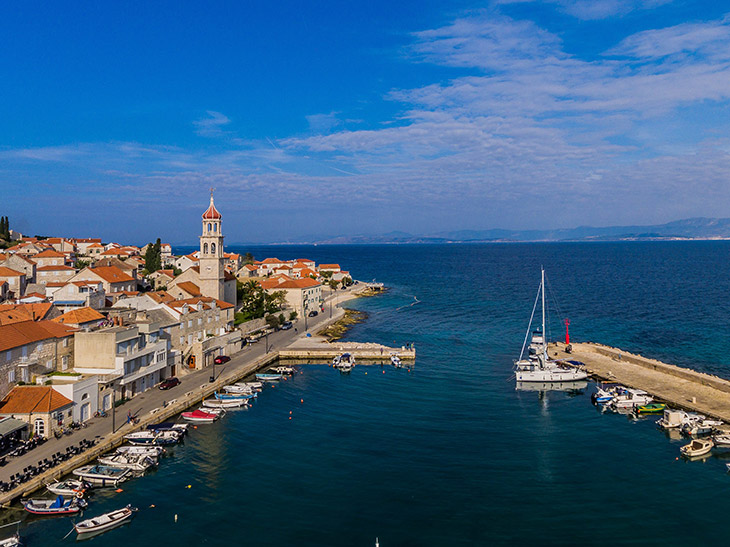
While the Roman emperor Diocletian built his palace in Split, one of his dignitaries built his own under the today court Kavanjinovi dvori.
We can speak about a 1700-anniversary of life in the village which is called nowadays Sutivan – it was probably named after St. John the Baptist (sv. Ivan Krstitelj).
Sutivan is a small and silent village with a Mediterranean atmosphere and beautiful beaches with surrounding forests, while the promenade goes from the little harbour Lucica to the bay Likve, Prbuje, Stinive, Stipanske, Male Tihe and the harbour Vicja luka.
Place of cleanest sea, where every guest can find only peace, physical and psychical health and lightheartedness.
Sutivan has about 1000 inhabitants.
Sutivan local population is historically connected to agriculture, fishing and seamanship.
The agriculture is quite developed. A reason for that are the fertile fields and the diligent hands of the domestic population.
Sutivan is surrounded with arranged olive-plantations, vineyards and mandarin- fields to which you come by regular roads. The pedestrian and bicycle-paths are ideal for sport and recreation.
In the little harbour there is less and less fishing, and there are more and more sport- boats. Once there swayed the masts of big sailing-ships which sailed to Venice and over Otranto.
Places to visit in Sutivan on Brač island
House-fortress of Jakov Natalis-Bozicevic, built in 1505 at the bottom of the bay from the early age.
Castle Kaštil Marijanović from the 17th century is preserved in the eastern part of the harbour.
Very near in the same complex is the beautiful and harmonious summer cottage of Kavanjin built from 1690 to 1705 with a baroque garden.
You can find a few well preserved economical objects around the summer cottage.
It is significant to mention the complex of houses of the families Ilić-Definis, Ivanović, Lukšić and the Townhall. The cultural monuments in Sutivan are grouped around two churches- the old and the new one.
Croatian church of St. John in Sutivan
On the cape Sutivanska Punta in the 6th century there was the old Croatian church of St. John, the oldest in this part of the island.
Parish church of Ascension in Sutivan
The second complex of monuments is the parish church of Ascension, built in 1579 in the time of the late renaissance forms with a beautiful baroque bell- tower with open loggia and a final arch untypical for the campaniles on Brač island.
The church of St. Roko was built in 1635, and later reconstructed.
Accommodation in Sutivan
Sutivan develops into a tourist destination adequate for family, sports and recreation tourism.
More than 2000 excellent beds in private houses and villas, and about 10 gastronomic objects are ready to receive everybody who.
The guests can rest in Sutivan during the whole year because of the good climate and the diversity of offer.
Special attraction is the Park Nature Sutivan, an extraordinary site for excursions, adequate for rest and fun for both the old and the young ones.
You can visit a zoo, grounds for recreation (bowling, basketball, small football, beach- volleyball, swing, sand for the children etc.) and relaxation by the fountain with a excellent offer of drinks and dishes from the grill.
Village of Selca on Brač island
Selca is located in the eastern part of the island of Brač, 36 kilometers from Supetar.

It is formed of three smaller tourist villages: Selca (Puntinak), Sumartin and Povlja. Beside the rich cultural history and the attractive natural beauty Selca also offers 1400 beds in private accommodation.
The first monument to dedicated to russian writer Lav Tolstoj in the world was established in 1911 in Selca. It is situated in the park Tolstoj.
At the end of the 19th century lived in Selca the Slovakian writer Matej Bencur – known under the pseudonym Martin Kukucin, author of the roman, “Dom v strani” – wrote about the then events on the island Brac.
The famous poetical manifestation “Croatia rediviva” is organized every year in the first weekend after the local celebartion of Madonna of Karmel/ Gospa od Karmela (July 16th). There you can meet numerous poets from the whole Croatia.
Splitska on Brač Island
Splitska – small island settlement located 8 km east from Supetar.
It was developed in the 16th century, after the foundation in the 13th century when the pirates from Omiš destroyed it.
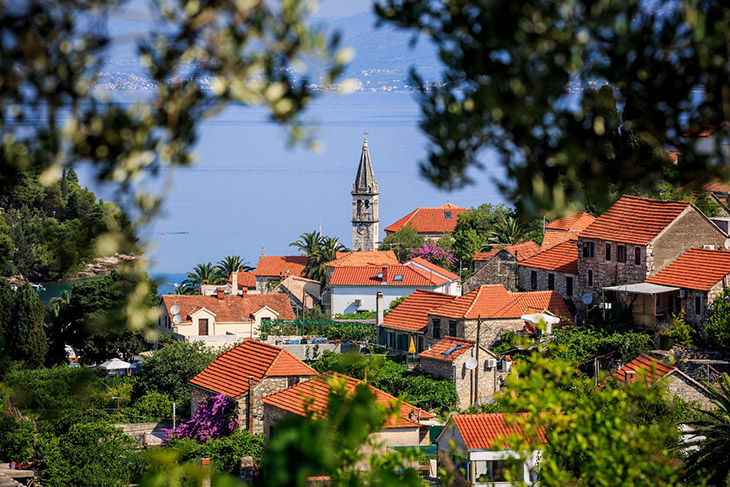
Church consecrated to the Blessed Virgin Mary in Stomorna was built on the foundations of an older church from 1228. The altar pale of the Virgin with Saints has painted Leadro Bassano, a renaissance painter from Venice in 1577.
The court of the family Cerinic was built in 1577. In the ancient time was in Splitska port, from which the stone from the island of Brač was transported towards construction of the Diocletian’s palace in Split.
Near Splitska you can see in the stone-quarry Rasohe a relief of Heracles, which probably has been made by slaves, who worked in the quarry.
Visit Sumartin
Sumartin – latest formed settlement – fishermen’s village on Brač.
Ferry-port in Sumartin connects a part of the island with the land. It is worth to visit the Museum of the monastery of fra Andrija Kacic – Miosic which has very worthy paintings among them especially the early baroque Last Supper from the second half of the 17th century.

The documents written in “bosančica” from the period of 1665 – 1755 are also very valuable.
Sumartin locals main occupations are farming, viticulture, olive growing, fishing and tourism.
Situated on the regional road running along the island; ferry port and connection with Makarska.
The village set in the vicinity of the big quarries, used the stone for the paving of lanes, for the dents (the nails) on the house walls, for the doorways and for the stone seats in the shade of the clumps of trees in the Sumartin yards.
Places to visit in Pučišća
Pučišća – settlement located in the center of the northern part of the island Brač turned to the channel of Brač, Omiš and Makarska.

Pučišća originated on stone, at stone and from stone. With population of 1706 inhabitants, along with Supetar, this is the second biggest town on Brač with original Mediterranean characteristics.
White roofs are creating a true Mediterranean ambient atmosphere. It is located at the bottom of a deep bay which splits into two smaller bays: Pučiski dolac and Stipanska port.
Pučišća is rich of stones and exactly the excellent local stone has contributed o the development of the town.
The work with the stone and the life from it are brought over from generation to generation.
Today a stonemason- school is working there. Many palaces throughout the world have been built with the local stone from the renaissance age until today.
The works, mainly sculptures of contemporary domestic and foreign sculptors are set on many public places, which are from the same stone. Other economy branches are cattle-breeding and agriculture.
Pučišća surrounding, like on whole island of Brač, is famous for the production of olive-oil, vine, and figs. Since ages sheep and goats were raised.
Due to the various Mediterranean plants and grasses, and the sea and mountain air on the higher locations Brač island is a true paradise.
In Pučišća you can always search and discover other natural blessings. In this way they find and strengthen their top position in the tourist offer.
Beaches in Pučišća
Pučišća beaches are with fine gravel and stone beaches, with a lot of small bays, were everybody can find his intimate corner.
Constantly new beaches are being arranged, which are especially suitable for small children.

Those who want can choose their holiday in a villa in Praznice or Gornji Humac where especially children have the opportunity to experience the rural parts of Brač island.
The Robinson type of tourism is also represented – only you, the sea and the sun.
The beauty of Pučišća is eternal – therefore the perfect harmony of stone and tourism in this place of sun, stone and salt is not a question at all.
Main attraction in Pučišća
Pučišća have been and still are a strong cultural centre of Brač.
Already in 1516 the first private school on the island was established in Pučišća.
The chronics Vicko Prodić, Petar Dominis, Trifun Mladinić, Andrija Ciccarelli are famous as well as the writers Jure Zuvetić i Sabo Mladinić.
In Pučišća have worked also the very famous stonemasons Juraj Dalmatinac, Andrija Alesi and Nikola Firentinac.
The builder and constructor, military engineer Ivan Puljizić was born in Pučišća in the middle of the 17th century and he worked on the court of the Pope Inocent X.
From Pucisca is also Trifun Bokanić, the outstanding builder of the third floor of the cathedral in Trogir.
Here are also born the two best sculptors from Brač Branko Desković and Valerije Michieli.
Castle of Ciprijan Zuvetić
Castle of Ciprijan Zuvetić is outstanding among the monuments of the profane architecture. The castles are a brand-mark of Pučišća and very interesting from the historical point of view as well as from the architectural point.
There is also the Palace of the family Moro, today the official building of the Municipality Pučišća, and the Primary school Pučišća from the times of the Austrian- Hungarian government, which opened in 1902, and was totally renewed in 2004.
Povaljska Listina
Extraordinary cultural and historical monument is the famous Povaljska Listina which is kept in the parish court.
According to its original from 1184 it is the oldest preserved document written in Croatian language and Croatian letters.
The Listina is one of our oldest and most important language monuments in general.
The most monumental sacral monument is the parish church of St. Jerolim, built in 1566 and spread in 1750.
There is also the church of the Blessed Virgin Mary with a bell-tower and the cemetery in Botak.
Around the church of St. Stephen, on the local cemetery are found one of the oldest settlement: a pagan altar and a Roman grave stela.
Almost a trademark of Pucisca is the small church of St. George on Bracuta, right from the road to Postira.
In the present days Pučišća have a branched cultural activity which reflect itself in many cultural manifestations, especially in the Cultural Summer-festival – concerts of classical, pop and jazz music, performance of klapa – Dalmatian traditional a-capella, exhibitions, guest theatres, lectures, promotion of books, literature evenings, and various sports- events.
Already eight years acts the International Summer Music- school, and the third year the Summer Music- festival of Brač.
Village of Postira
Postira – first mentioning dates back in 14th century.
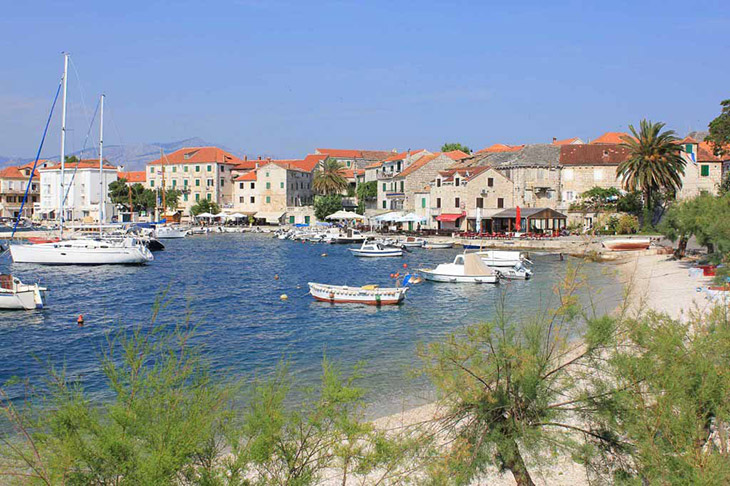
Postira is a little Mediterranean town located on the northern side of the island Brač, 8 kilometers from Supetar.
Coming out from the clear blue of the Adriatic, Postira climbs up the hill to embrace the centuries old olive fields and pine forests that partly replaced dead vineyards and also it comes into the fertile valley of vine yards and tangerine to the south.
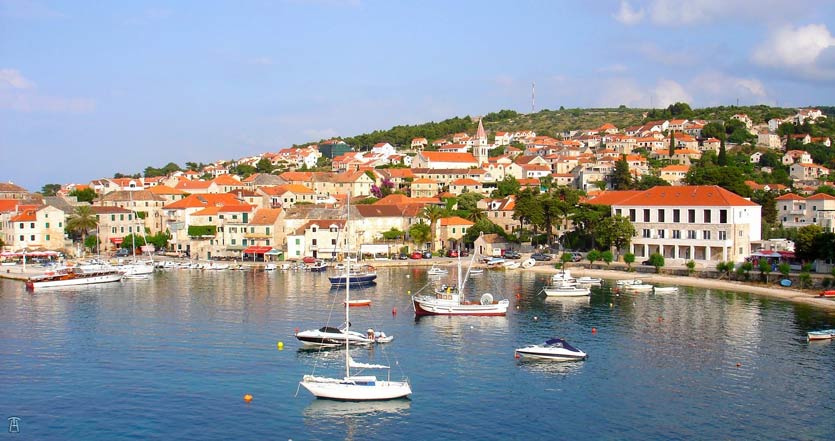
Postira stretches their roots deep into the past, three early Christian localities proving you that and among them the most famous are the remains of a basilica in Lovrecina, a bay with a source and a very beautiful sandy beach.
Postira is beautiful in every season of the year. The village is decorated even in January with the almond-bloom.
When the crazy time of carnival stops, and the cold northern bura winds clear the sea and the landscape, the vineyards and the fig plantations put forth buds, and the meadows become green.
Young sheep were born and sage, heather and the yellow glister are …. the nature.
During summer time Postira shows its hospitality.
Many bays and beaches come to life by the variety of the domestic tourist offer. While the cicadas play their concert, you can hear also the song of travelers and smell the fresh fish from the grill.
Postira is beautiful also in the autumn. Left alone, it entertains itself with the vintage of grape, mandarins and olives, and the vineyards become lively by the songs of the hard-working people.
The new cultivated plantages of golden-coloured fruits and the century old olive fields are filled with this the God given tree announce also new times of post- season and ecological tourism.
In the winter Postira isn’t also without its magic: Christmas- Eve, the ethnic-colors of church rituals, the long evenings around the fire- place.
The November rain covers the thirsty soil. And when for change the cold bora- wind touches the core of the bones, the wood collected in autumn burns, gives warmth and calls into the memory the ancient times of mythological Brač of whom the writer Vladimir Nazor, who was born in this little town, talks in his poem “Shepherd Loda”.
There are hidden beauties in every season, friendliness of people and the hospitality in the comfortable hotels and private apartments will remain for long time in your memory.
Milna on island of Brač
Milna – small village located on the western part of the island Brač, 18 kilometers from Supetar.
It is famous by its entrancing Milna bay, in which the ships of the emperor Diocletian have found a secure port in the past time when they are working on his palace in Split.
There is a marina with several berths, modern equipped for a secure stay and the service of yachtsmen from the whole world.

Legend about the beauty of the harbour Bobovišća, the villages Ložišća and Podhume and the surrounding bays have passed the Croatian borders a long time ago.
Crystal clear sea, domestic healthy food, ideal condition for diving, sailing, fishing, and a fast connection to the land: a catamaran from Milna and a ferry from Supetar, an airplane from the 35 km far away Airport Brac, are the main means of the arrival of guests to Milna, which is built in a typically Mediterranean style with a baroque church finished in 1783 in which is the most beautiful altar pala on the island Brac.
Mirca village
Mirca – picturesque village located 3 km on west from Supetar, less than half an hour walk and the old part of the village is south to the main road.
Mirca was founded by the inhabitants of the nearby Sutivan and Donji Humac in the 16th century.
During the 18th century was built the church of Marys Annunciation. In the church you can see the pala Madonna of seven sorrows, a work of the painter Felix Tironi from Supetar. Pave Gospodnetic, a painter of naive art from Postira, created the paintings of St. Ciril and St. Metod.
Mirca offers a peaceful and quiet surroundings to tourist, detached from main tourist sites, while in the same time close to everything.
Villages of Pražnica and Gornji Humac
Do not miss to visit the villages which are located in Pučišća area.
Pražnica is an old village from the Middle age about 7 km south of Pučišća, at an altitude of 391 m and with 350 inhabitants, who are living mainly from agriculture and cattle-breeding.
Almost every road leads to a church. The oldest church is consecrated to St. Ciprian and originates from the 11th century. The parish church of St. Ante was built in the year 1461.
Around Praznice are a huger number of piles of pra historian tombstones.
Gornji Humac is one of the oldest existing settlements of shepherds and farmers on the island.
The place is 13 km away from Pucisca, from Supetar 24 km, and from Bol 10 km. Main attraction in Gornji Humac is impressive building of parish church of St.Nikola.
The place completely burned out in a fire in 1943, and it has risen from the ashes like the Phoenix. In present days Gornji Humac is proud of its numerous picturesque taverns (konobas) and inns.
The one who visit these villages will never forget how important clean and fresh air is. The ecological authentic Brač island cuisine will rest in a nice memory.
You will certainly came back again.
Bol on island of Brač
Bol – located on the south part of the island Brač, and is the oldest town on the coast of Brač.
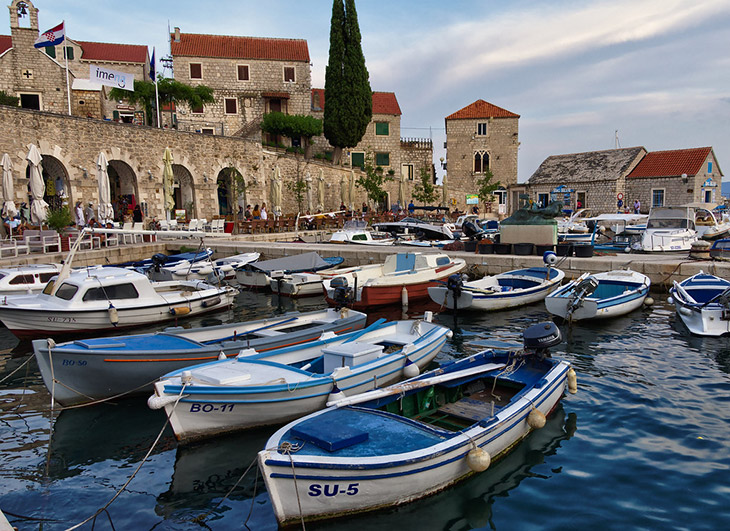
This little town was founded long ago and became an extraordinary tourist oasis because of the wide gravel and sandy beaches which expands over 10 km and the sources of drinking water.
It is not possible to avoid the Zlatni rat, certainly the most beautiful beach on the Adriatic sea, whose cape is turning one moment to one side and the other moment to the other side playing a strange game with the wind and sea currents.
Thing to see in Bol
Right above town there are a rising the coronet of Bol hills, the illlyrian fortress Kostilo (660 m) and the Vidova gora (778 m), the highest top of the Adriatic islands.
Bol is only 15 km away from the international airport of Brač, and excellently connected with the fast lines to the coast, but also with a ferry- line from Supetar.
Bol will fascinate any visitor with crystal clear water, wonderful nature and the virgin beauty of the stony island houses the Croatian poet Tin Ujević sung about.
This little town has kept its Mediterranean spirit. The narrow, stony little roads and the wide piazzetta are simple and typical Mediterranean rustling.
Monuments in Bol on Brač island
When you visiting Bol you will open the doors of history, which are going back to the ancient times. The Roman piscinas testify it and the grave monuments (stela) and relief.
There are also the old Christian sarcophagus with the engraved crosses,
- Pre Romanic church of St. Ivan and St. Tudor (11th century) on which foundations is discovered an late antique group of buildings, the residence of the bishop (12th century)
- The church Madonna of graces (15.-17th century)
- Fortified gothic summer palace (end of 15th and beginning of 16th. century)
- The renaissance and baroque palace with the worthy gallery of contemporary Croatian art ‘Branislav Deskovic’ (end of 17th century)
- Local church Madonna of Karmel with the motive of an angel with the handkerchief of Veronica (finished at the end of the 18th century)
Bol was first mentioned in the year 1184 because of the council of the island authorities, when the manuscript Povaljske listine originated (the oldest Cyrillic paper wrote with Croatian language).

A special importance for the spiritual and cultural life of Bol was the founding of the Dominican community in 1462, and the construction of the monastery in 1475 which keeps today collections of pre historical and ancient maritime archeology, Roman and early Croatian architectureand sculpture, a numismatic collection, and collections of incunabula’s and sacral objects.
The museum has also a painting Madonna with child and Saints from the Venetian painter Tintoretto from 1563.
Town has more than 2500 beds in private accommodation.
Beside a huge number of little restaurants by the sea, discotheques and clubs, this place offers also relaxing moments with tender Dalmatian klapa, concerts of prominent opera singers, theatre, and art exhibitions of popular Croatian artists who have found in the silence of Bol their moments of inspiration.
Sport and sport events in Bol
As the biggest tourist centre on the island, Bol offers its guests twenty playing-grounds, a big tennis stadium with 1820 sitting places on which every year the tennis elite is coming together – the players of the popular competitions Jadranska rivijera and WTA Croatian Bol ladies Open.
Place is ideal for the lovers of futsal, volleyball, basketball, byciclis, and the extreme sports like trekking, free climbing, the water sports like diving and windsurfing.
In the aquatorium of Bol you will find a true paradise for surfers, always attractive because of the extraordinary good winds.
Climb on Vidova gora
The nearby Vidova gora is a paradise for adventurers and mountaineers, collectors of mushrooms, sparogs and healing plants.
In the Mountain resort ‘Vladimir Nazor’ you can invigorate yourself with specialities from Brač, and you will maybe hear old Slavic myths like the one of Sevid, the cult of light.
Certainly you have to visit the glagolitic hermitage Blaca with a monastery from the 16th century, and the Dragons cave (Zmajeva spilja) with interesting reliefs.

Bol in its excursion program offers regularly visits to the neighbour island Hvar and the towns Split and Dubrovnik.
